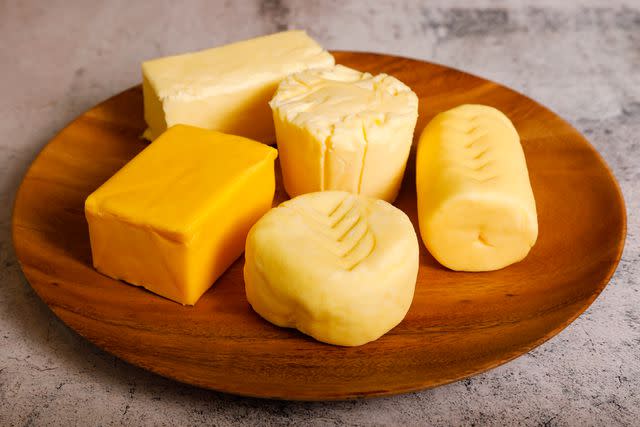The Different Types of Butter and When to Use Them
Pick the right butter for the job every time.
It used to be that butter was a no-brainer, whether you were at the grocery store or standing in front of your refrigerator: The only decision you had to make was salted or unsalted. But these days, there is a proliferation of options in the stores, and more and more recipes and recipes are specifying specific styles of butter.

Alejandro J. Vivas / Shutterstock
Confused about the difference, and where and when you should use the various types? Let’s debunk the butter aisle.
Related: Making Butter Is Easier Than You Think
Unsalted butter
Unsalted butter is the all-purpose flour of the butter world. If a recipe simply calls for “butter,” this is the one to choose. Unsalted butter has a pure, creamy flavor. Its use in recipes allows the cook to have complete control over salt levels, making it a go-to for both baking and savory cooking. Unsalted butter will usually have 80% butterfat, and 16 to 18% water. I like to buy packs of “half-sticks,” which give me the most flexibility with butter, especially for baking.
Salted butter
Unless a recipe specifically calls for salted butter, it is generally best used for spreading on toast, radishes, crackers, and other straight usage. Salt was originally added to butter as a preservative, and as such, it was often believed that commercial salted butter used lesser quality or older cream. These days, it is really just a flavor preference. If you are team “Butter on the Counter,” salted will be your best bet to pack into your butter bell, as it will last longer than unsalted.
Related: Do You Leave Butter Out on the Counter or Keep It in the Fridge?
European-style butter
European butters have a higher butterfat percentage than American butters, and have become the butters of choice for many chefs, bakers, and passionate home cooks. American butters have to have 80% butterfat to be called butter, European butters or American-made “European style” butters have between 82% and 90% butterfat (and a maximum of 16% water), which makes for a richer flavor. These are great for spreading on bread at the table, but also can make a lovely difference in sauces that are boosted with butter, or rich baked goods.
Whipped butter
This light fluffy salted butter comes in convenient tubs, and is a great option if you want butter that is more easily spreadable than sticks, even when right out of the fridge. These are a good choice if you live in a hot climate and leaving butter out isn’t an option for you. Perfect for toast, pancakes, baked potatoes and the like. If you like, you can make your own whipped butter by just whipping cool room temperature butter in your stand mixer or with a hand mixer until it is aerated and fluffy. Store it in an airtight container in the refrigerator. We don’t recommend using whipped butter in recipes unless you weigh it, as the aeration makes volume measures inaccurate for recipe use.
Vegan butter
There are a variety of salted and unsalted cultured vegan butters on the market. You can find options made with vegetable oil, almond oil, olive oil, avocado oil, cashew milk, and coconut oil. They taste and act just like dairy butter, whether you're baking, spreading, melting, or browning.
Related: The Secret to Great Vegan Baking and Ice Cream Is in These Ingredients
Clarified butter and ghee
Clarified butter is butter that has been cooked to remove the water and milk solids, leaving pure butterfat. This gives it a much higher smoke point, which means you can cook with it without risk of burning. Unless you are shopping at a restaurant supply house, you will need to make your own clarified butter.
Ghee is a South Asian style of clarified butter, where the milk solids have been left to brown before straining, giving it the addition of a lovely nutty flavor. Ghee is readily available in grocery stores and is a wonderful product to keep on hand when you want to sauté or do other higher heat cooking and want that buttery flavor. Both are also great options for those who have dairy sensitivities, but not allergies.
Browned butter
The French call brown butter “beurre noisette,” or hazelnut butter, as a nod to its deep brown color and nutty, complex aroma and flavor. Brown better is butter that is melted and then cooked further, until the water evaporates and the milk solids brown and become toasty.
Related: The Best Butter Dishes, Recommended by the Pros
Cultured butter
Cultured butter is made with cream that has been allowed to ferment slightly, intensifying the flavor and bringing some lovely tangy notes to the final product. It is great for spreading on bread, garnishing vegetables, or making compound butters, and is especially good drizzled on popcorn. We don’t recommend using it in recipes unless the text specifically calls for it, since the tangy flavor can be pronounced.
For more Food & Wine news, make sure to sign up for our newsletter!
Read the original article on Food & Wine.


